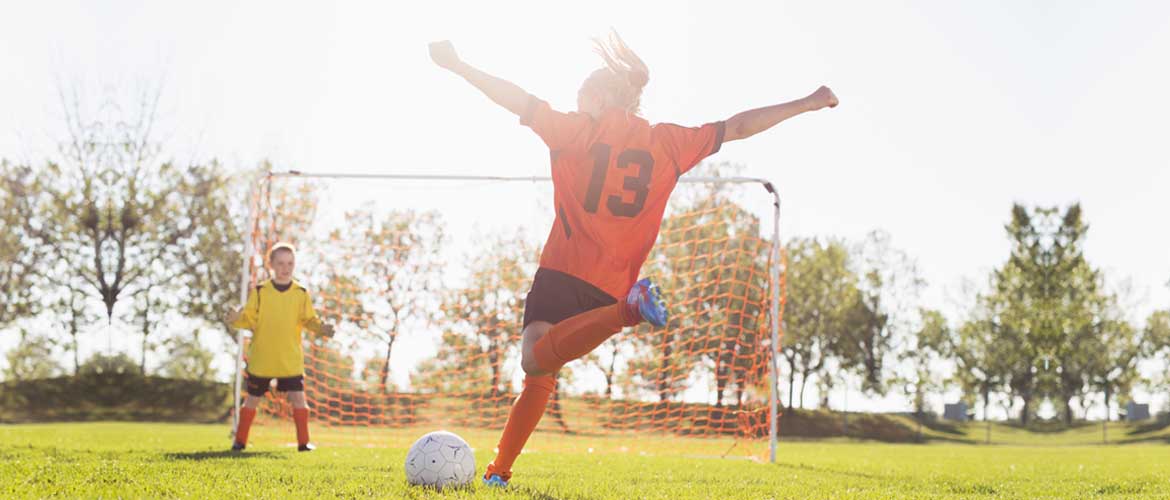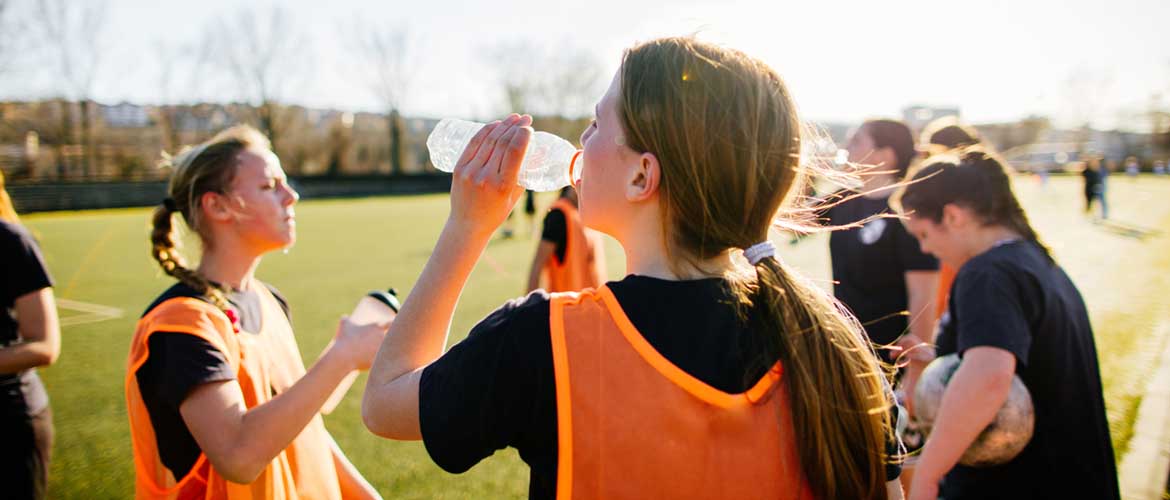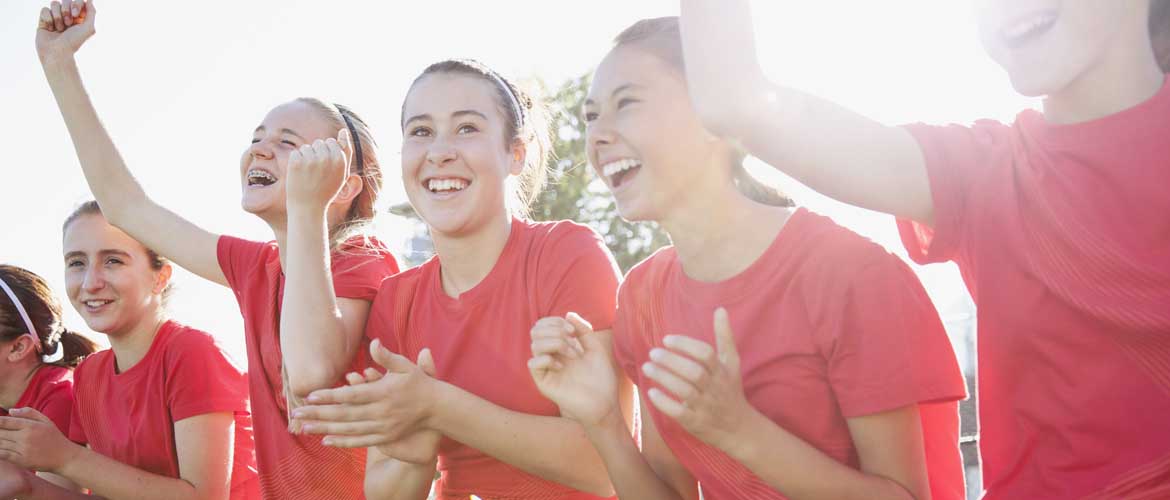September 18, 2017
Sports are a great way for you and your child to stay active and make memories for years to come. But, a sports season can also lead to unanticipated casualties. Want to make sure your child is spending more time on the field than the sidelines? Here are four tips for parents to help keep the season injury-free.

Get the Ball Rolling
Think of it this way - you’re the coach off the field. You make the game plan. You call the shots. And while accidents may still happen, you can get the ball rolling on injury prevention long before your young one gets those game day jitters.
First step, chat with your child. Setting the tone for the season starts with you. Sports can require a lot of time and energy. Before your child makes the commitment, be sure to emphasize the importance of maintaining good health – even at a young age. Nutrition and rest will be key factors in creating a safe and enjoyable season. In fact, many famous athletes have daily routines to keep their bodies in the best condition. Who does your future champion idolize in the world of sports? It may be fun to research his or her thoughts on the ins-and-outs of athletic care.
Once you’ve had the chit-chat, schedule any necessary or required sports physicals. Typically, a coach or team facilitator can provide you with the appropriate paperwork for the visit. Be prepared to also share any pertinent health information, such as asthma or childhood illnesses, as this will be helpful in determining that your child can safely play. During a sports physical, the healthcare provider will check vitals, joints, flexibility, and vision. In addition, the healthcare provider will look for any physical limitations during a short fitness assessment. It’s quick, painless, and gives you the peace of mind that your child is ready to tackle the activity ahead.
Finally, get your kid equipped for success. Dependent on what sport your child is looking to play, a variety of tools will be needed to help reduce injury, and provide comfort and support during the laps, drills, and jumps. It’s worth investing in quality gear, but before you do so, consider the fit and flexibility of each piece. For example, when wearing a football helmet, the skin should move as the helmet moves – not too tight, but comfortably secure. Always try the gear on, and if possible, test out some athletic movements while wearing it. When shopping for the perfect supplies, don’t be afraid to ask a sports sales associate for insight on brands and sizing. In addition, it’s helpful to read reviews before the point of purchase to make sure the product doesn’t have any common defects.

No Hocus-pocus, Just Focus
Although you may not be able to demonstrate a quarterback sneak, reverse layup, or forward roll towards the soccer net, you can most certainly contribute to your child’s athletic progression. By organizing at-home games like Arm and Leg Tag, and other drills shared by Ace Fitness, you can work towards keeping your child’s muscles strong. When muscles and tendons are strengthened, they are better able to protect our bones when the body experiences impact. Before participating, remember to warm-up the muscles with a walk or light jog. And when finished, do the same to cool down. These movements will reduce muscle stiffness. Be sure to talk to your doctor before beginning any new exercise regime.
Additionally, as the parent, you have the opportunity to focus on something many athletes often forget – stretching. Flexibility not only gives us a greater range of motion to better perform on the clock, but it also helps reduce the risk of a sports injury. Stretching is done to decrease muscle resistance and keep the blood flowing throughout our bodies.
MedExpress Pro Tip: After practice, have a ten minute family stretch. Most likely, your child is already running through the scrimmage stats. Why not make extra use of that time?

Call a Timeout, Coach
Between all of the carpools, dirty kneepads, and weekend tournaments, it’s easy to get caught up in the battle towards playoffs. Don’t forget, you have a timeout up your sleeve. Blow that whistle, huddle your team, and remember the simpler steps to becoming an all-star.
Is your child getting the right nutrition or just snagging fast food after late night games? Do your best to provide the little competitor with a well-balanced diet. By fueling your child with the right ingredients, you’re providing the energy needed to push through the game with a tied scoreboard.
MedExpress Pro Tip: Prep and pack the right post-practice snacks like fruit, hard-boiled eggs, or a peanut butter sandwich, assuming no food allergies are present.
With the right food, make sure to hydrate, hydrate, and hydrate again. Whether it be in the hot outdoors or a stuffy gymnasium, it’s a smart move to stay ahead of heat-related illnesses. On average, your child should drink between six and eight cups of water each day. However, during activity, it’s best to have a half cup to two cups every 15 to 20 minutes of exercise.
Even with a healthy diet and lots of liquids, one of the most valuable pieces to a successful season is getting enough rest. Make it a priority. According to the National Sleep Foundation, children between the ages of 6 and 13 years old should sleep roughly 9 – 11 hours a night, and those between the ages of 14 and 17 years old should sleep roughly 8 – 10 hours a night.1
In addition to a good night’s rest, your child needs time off, too - a day or two a week with no practice, games, or tournaments. Overuse is one of the most common injuries in younger athletes. Do your best to recognize the signs that your child needs a break. A small break now has the ability to prevent forced time off later on.

A Game of Two Halves
Football is considered to be a game of two halves. We as humans can be thought of as two parts, as well - physical and emotional.
The world of sports can be a competitive place, and let’s face it, that’s what makes it fun! There could be a rivalry game this Friday or an internal team battle for that starting spot. Either way, your child will likely participate in a little friendly competition. This is normal as long as everyone is being a good sport. Make sure the stress isn’t becoming a burden. Communication is key. Continue to ask your child what is most enjoyable and most frustrating. This will give you the chance to remind your go-getter what the sport is all about – learning, improving, but most importantly, enjoying the game!
Should your child, family member, or friend experience a sports injury or heat-related illness, visit your friendly, neighborhood MedExpress. We offer convenient hours, so the road to recovery can start sooner.
References:
1National Sleep Foundation: How Much Sleep Do We Really Need?
